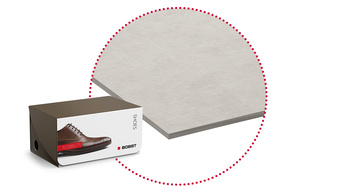Processed materials
Corrugated box makers around the globe are able to exploit new markets by improving the quality of their flexo post-print. BOBST has been at the leading edge of this technology since the introduction over forty years ago of the FLEXO -1575, and today our flexo printing presses set the standard for what can be achieved with the offline flexo post-press process.
We have achieved this by researching and developing new systems, working with industry leading partners, and by constantly listening to the views of our customers. BOBST flexographic printing machines cover a wide range of different production needs, from straightforward block print to the highest quality process work, along with offering the performance, versatility, and reliability which modern manufacturing demands.
Corrugated board
Corrugated board is manufactured by combining lining paper with a fluting medium in a unit called a single facer. The liners used may be made from recycled, test, or kraft papers, and will consequently have a brown or white surface, which may be coated or semi-coated, depending on the application they are to be used for. Fluting medium is generally recycled paper.
In the single facer unit, heat, steam, and a corrugating roller are used to corrugate the fluting medium, which then has the liner attached. This creates single face, the basic building block of all corrugated board. Single face is used 'as is' for some specific applications such as litho-lamination, but is normally combined with further liners and fluting media to produce single wall corrugated (single face plus a top liner), double wall (single wall plus single face), or multi-wall (further combinations of the above).
The thickness of the corrugated material will depend on the fluting height created by the single facer and the combination of flutings used. The range of thicknesses can vary from 0,5 mm for the finest, up to 15 mm for the thickest, and sometimes more. The most commonly used grammages are in the range from 80 gsm to 300 gsm, however for some specific applications lighter or heavier papers may be used.

Heavy solid board
Heavy solid board is a type of carton board with a high basis weight.
To manufacture heavy solid board, fibrous material, either from trees, recycled paper, or a mixture of the two, is turned into pulp. It is then bleached and processed in a board making machine to create a board consisting of one or more layers, which may optionally be coated to provide a better surface and/or improved visual appearance. The resulting board will normally be heavier than 1000 grams per square meter (gsm).
Heavy solid board is primarily used in the packaging industry for applications where a high level of mechanical strength is required, such as trays for meat products or puzzle.
